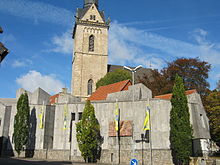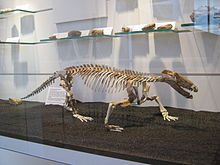Wolfgang Bonhage Museum Korbach

The Wolfgang Bonhage Museum in Korbach ( original spelling : Wolfgang Bonhage MUSEUM KORBACH , also: Museum Korbach ) is a city museum in the Waldeck-Frankenberg district in northern Hesse . Because of its collection (including fossil finds in the Korbach Column ) and its multi-award-winning architecture, it is of national importance. The museum is named after Wolfgang Bonhage (1937–2004), who was mayor of Korbach from 1977 to 2001 and who played a key role in expanding the museum.
history
The Wolfgang Bonhage Museum goes back to the private antiquity collection of the Korbach bookbinder Carl Nelle (1858–?), Which he started in 1876 and donated to the city in 1924. That is why the city founded a local history museum in 1925, which was set up in the city center near Kilian's Church in a Gothic stone house from the 14th century. The fireproof building was originally a warehouse . In the 16th century it was bought by the brothers Johann (1532–1577) and Otto von Wolmeringhausen (1530–1591) and converted into a representative town house.
The size of the collection was steadily increased in the following decades through acquisitions and donations. That is why the museum was gradually expanded in 1934 and after the Second World War to include three neighboring half-timbered buildings from the 18th and 19th centuries. From 1994 to 1997, the museum was supplemented by a modern new building designed by Kassel architect Berthold Penkhues - also in order to be able to appropriately display the fossils discovered in the Korbach Fissure since 1964.
The museum building subsequently received several awards for its combination of historical buildings and contemporary architecture - including a special prize from the German Urban Development Prize in 1999 . In 2015, the GeoFoyer Kalkturm Korbach was opened as a branch of the museum at the Korbach Column , which deals with the creation, extraction and processing of limestone.
exhibition
The museum has had an exhibition space of around 1,700 square meters since its expansion in 1997. The focus of the collection is the history of the city of Korbach and the region, the regional mining for gold , iron and copper on the Eisenberg as well as the extraction and processing of limestone (branch GeoFoyer Kalkkturm Korbach ).

The part of the exhibition about the fossil finds in the Korbach Column is of supraregional importance . The column is in a former limestone quarry on the southern edge of Korbach minded . Limestone, crevice and crevice filling emerged in geologically relatively short succession around 255 million years ago in the Upper Permian (" Zechstein Age "). The sedimentary rock of the fissure filling contains fossils of Upper Permian terrestrial vertebrates . In the museum, among other things, a skeleton and living reconstruction of a Procynosuchus ( Greek "pre-dog crocodile", also jokingly called "Korbacher dachshund" - although numerous specimens of this form were known long before the discovery in the Korbach column from South Africa) a genus of non-mammalian therapsids from the large group Cynodontia . Live reconstructions of other Therapsids from the Upper Permian are shown in a diorama .
Exhibits on the Korbach Column
- Diorama with live reconstructions of Upper Permian animals
Live reconstruction of Procynosuchus ("Korbacher Dachshund")
Live reconstruction of Diictodon
The film archive of the German media artist Thomas Henke has been located in the museum since spring 2017 .
architecture
The Wolfgang Bonhage Museum Korbach is located in the center of the city between the Gothic Kilian's Church and the medieval market square. It consists of a group of four historic buildings located on the church square and a modern extension on the Stechbahn street .
The historical parts of the building are a Gothic stone house from the 14th century and three adjacent half-timbered buildings from the 18th and 19th centuries.
The stone house was built from quarry stone masonry . The unplastered outer walls show that the original warehouse has been rebuilt several times. You can see that the double-winged entrance door on the ground floor and a window to the left and two windows on the first floor were added later - presumably when the building was converted into a residential building in the 16th century. The top floor with a gable roof has two dormers with windows on the street side and is crowned by a five-stepped gable . The three half-timbered houses also have gable roofs and some quarry stone masonry, but they are each smaller than the stone house.
The modern extension from the 1990s, together with the historical parts of the building , encloses a narrow atrium covered with glass . The new building of the Kassel architect Berthold Penkhues is by smooth facades of limestone coined. The structure is divided into four sub-buildings and thus takes up the appearance of the four historical building parts of the museum. Several large windows on the outside and a glass roof over the inner courtyard give the entire group of buildings a spacious appearance and let in plenty of light.
Interior shots of the museum
Gallery on the first floor of the museum.
View from the atrium onto Kilian's Church .
Awards
- 1998: Simon-Louis-du-Ry badge from the Association of German Architects
- 1999: German Urban Development Award (special award)
- 2002: Museum Prize of the Sparkassen-Kulturstiftung Hessen-Thüringen
See also
literature
- Hans Osterhold: My city. Korbach buildings tell the history of the city . 4th edition, Korbach 2011
Web links
Coordinates: 51 ° 16 '16.8 " N , 8 ° 52' 21.4" E









